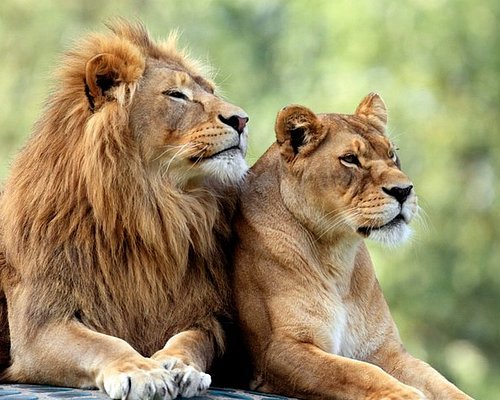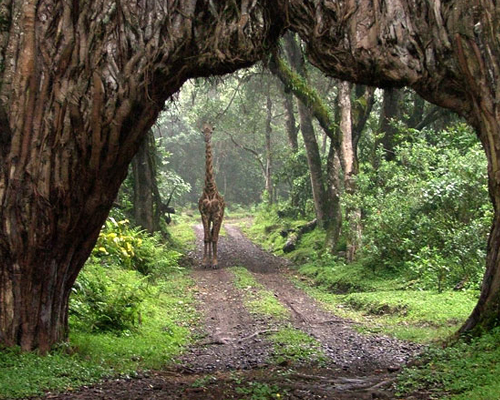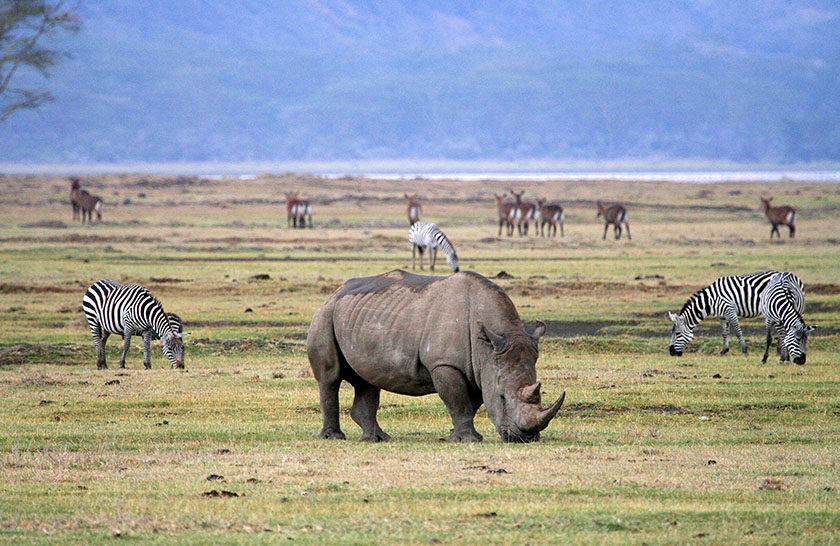
Exploring the Wonders of Arusha and Ngorongoro Parks: A Journey Through Tanzania’s Natural Beauty
Tanzania is home to some of the most breathtaking natural landscapes in the world, and Arusha and Ngorongoro Parks stand out as two of the country’s most iconic destinations. Each park offers a unique and unforgettable experience, combining stunning scenery, rich wildlife, and opportunities to connect with nature in profound ways. Whether you’re a seasoned traveler or a first-time visitor, these parks promise an adventure that you will cherish for a lifetime.
1. Arusha National Park: The Gem of Northern Tanzania
Nestled at the foot of Mount Meru, the second-highest peak in Tanzania, Arusha National Park is a hidden gem that offers diverse landscapes and wildlife in a compact area. The park is located just 25 kilometers from Arusha town, making it an easily accessible destination for day trips or the starting point of a longer safari.
Highlights of Arusha National Park:
- Mount Meru: This majestic mountain offers challenging but rewarding treks that provide panoramic views of the park and, on clear days, Mount Kilimanjaro. The climb is less crowded than Kilimanjaro and is perfect for those seeking a quieter, more intimate hiking experience.
- Momella Lakes: These shallow, alkaline lakes are home to a stunning array of birdlife, including flamingos, herons, and pelicans. A canoe safari on the lakes offers a tranquil and unique way to observe the wildlife up close.
- Ngurdoto Crater: Often referred to as the “Little Ngorongoro,” this lush crater is filled with swamps, streams, and dense rainforest. It is a great spot to see buffalo, warthogs, and Colobus monkeys against a dramatic backdrop.
- Diverse Wildlife: While Arusha National Park is not known for the “Big Five,” it offers sightings of giraffes, zebras, elephants, and numerous antelope species. The park’s dense forest is also one of the best places in Tanzania to spot the black-and-white Colobus monkey.
2. Ngorongoro Conservation Area: The Cradle of Life
Ngorongoro Conservation Area is one of Tanzania’s most famous parks, recognized as a UNESCO World Heritage site. The centerpiece of this conservation area is the Ngorongoro Crater, the world’s largest inactive and intact volcanic caldera. This vast, sunken volcano is teeming with wildlife and offers some of the most reliable big game viewing in Africa.
Highlights of Ngorongoro Conservation Area:
- Ngorongoro Crater: The crater floor is a self-contained ecosystem, hosting around 25,000 animals, including the Big Five: lions, leopards, elephants, buffalo, and rhinoceros. The crater’s varied landscapes—swamps, lakes, grasslands, and acacia forests—create a dynamic habitat where wildlife thrives year-round.
- Olduvai Gorge: Often called the “Cradle of Mankind,” this archaeological site is one of the most important in the world. Fossil discoveries here have provided crucial insights into early human evolution, making it a must-visit for history and archaeology enthusiasts.
- Cultural Experiences: The Ngorongoro Conservation Area is home to the Maasai people, who have coexisted with the wildlife for centuries. Visitors can interact with the Maasai, learn about their traditional way of life, and witness their vibrant cultural practices.
- Endless Vistas and Landscapes: Beyond the crater, the conservation area includes expansive highlands, plains, and forests. Scenic drives reveal stunning vistas that stretch as far as the eye can see, often dotted with wildlife.
Best Time to Visit
Both Arusha and Ngorongoro Parks can be visited year-round, but the best time for wildlife viewing is during the dry season, from June to October. During this period, animals are more visible as they congregate around water sources, and the weather is ideal for outdoor activities. The rainy season (November to May) offers lush, green landscapes and fewer crowds, but access to some areas can be more challenging.
Tips for a Memorable Visit
- Plan Ahead: Both parks are popular, especially Ngorongoro, so booking your trip in advance is recommended, particularly for accommodations inside or near the parks.
- Go with a Guide: A knowledgeable guide can enhance your experience by providing insights into the park’s history, wildlife behavior, and local culture.
- Pack Smart: Bring layers, as temperatures can vary significantly, especially at higher altitudes. Don’t forget essentials like sunscreen, insect repellent, and a good pair of binoculars.
- Respect the Wildlife: Keep a safe distance from animals and follow your guide’s instructions. Remember, you are in their home, and maintaining a respectful approach ensures both your safety and that of the animals.
Conclusion
Arusha and Ngorongoro Parks showcase the best of Tanzania’s natural beauty and wildlife. Whether you’re marveling at the serene Momella Lakes or standing on the rim of the Ngorongoro Crater, these parks offer experiences that connect you deeply with nature. They are not just destinations—they are journeys through some of the most remarkable landscapes on Earth, where every corner reveals something new and awe-inspiring. Plan your visit to Arusha and Ngorongoro, and get ready to create memories that will last a lifetime.











Comments (75)
📠 + 1.666094 BTC.GET - https://graph.org/Payout-from-Blockchaincom-06-26?hs=dfb5e1db19d759036d977b35388ff667& 📠,
07 July, 2025idpjby
Lincoln3949,
06 June, 2025Ирина Аллегрова – В городе серых облаков скачать песню и слушать онлайн
https://allmp3.pro/2852-irina-allegrova-v-gorode-seryh-oblakov.html
Bryce4549,
06 June, 2025ALEKS ATAMAN, FINIK – Белыми ночами скачать песню и слушать онлайн
https://allmp3.pro/3273-aleks-ataman-finik-belymi-nochami.html
Harrison3607,
06 June, 2025Polikarpova – Длинные Ноги скачать песню и слушать онлайн
https://allmp3.pro/3283-polikarpova-dlinnye-nogi.html
Colette1148,
06 June, 2025Андрей Миронов – Ну чем мы не пара скачать песню и слушать онлайн
https://allmp3.pro/2491-andrej-mironov-nu-chem-my-ne-para.html
Abram3185,
06 June, 2025Big Som feat. L’One – Последний танец скачать песню и слушать онлайн
https://allmp3.pro/2638-big-som-feat-lone-poslednii-tanec.html
Leila3388,
06 June, 2025Лёша Свик – Луна скачать песню и слушать онлайн
https://allmp3.pro/2671-lesha-svik-luna.html
Esme728,
06 June, 2025Skina – Лопасти скачать песню и слушать онлайн
https://allmp3.pro/2747-skina-lopasti.html
Brian4039,
06 June, 2025Lookbuffalo – Италия скачать песню и слушать онлайн
https://allmp3.pro/3001-lookbuffalo-italija.html
Nia1444,
06 June, 2025Амур Успаев – Поздняя Любовь скачать песню и слушать онлайн
https://allmp3.pro/2888-amur-uspaev-pozdnjaja-ljubov.html
Ruben4538,
06 June, 2025Dead Blonde Feat. & Винтаж – Без Шансов скачать песню и слушать онлайн
https://allmp3.pro/3005-dead-blonde-feat-vintazh-bez-shansov.html
Gracie877,
06 June, 2025http://toyota-porte.ru/forums/index.php?autocom=gallery&req=si&img=3245
Edith1249,
06 June, 2025https://mazda-demio.ru/forums/index.php?autocom=gallery&req=si&img=6346
Lola863,
06 June, 2025https://mazda-demio.ru/forums/index.php?autocom=gallery&req=si&img=6595
David4260,
06 June, 2025https://vitz.ru/forums/index.php?autocom=gallery&req=si&img=4918
Nathan2521,
06 June, 2025https://vitz.ru/forums/index.php?autocom=gallery&req=si&img=4912
Morgan827,
06 June, 2025https://honda-fit.ru/forums/index.php?autocom=gallery&req=si&img=7060
Nelly1104,
06 June, 2025http://terios2.ru/forums/index.php?autocom=gallery&req=si&img=4763
Alice4423,
06 June, 2025http://terios2.ru/forums/index.php?autocom=gallery&req=si&img=4601
Ralph4001,
06 June, 2025http://terios2.ru/forums/index.php?autocom=gallery&req=si&img=4814
Brandon2226,
05 May, 2025Звери – Чайка скачать песню бесплатно в mp3 и слушать онлайн https://shorturl.fm/oUk57
Elsa31,
05 May, 2025Чи-Ли – Маки скачать бесплатно и слушать онлайн https://shorturl.fm/GLTnR
John946,
05 May, 2025Даша Волосевич – Алло, Привет скачать mp3 и слушать онлайн бесплатно https://shorturl.fm/K5VCQ
Genevieve968,
05 May, 2025Anik Feat. & Ignat Izotov – Больше Никогда скачать mp3 и слушать онлайн бесплатно https://shorturl.fm/IxfPn
Alexia4317,
05 May, 2025Света – Что Ты Такое скачать бесплатно и слушать онлайн https://shorturl.fm/Bgtyn
Geoffrey4535,
05 May, 2025ANNA ASTI – Сорри скачать и слушать mp3 https://shorturl.fm/4gRcl
Ashley2681,
05 May, 2025Тома Полак – Лова Лова скачать и слушать песню https://shorturl.fm/WxmHC
Douglas2158,
05 May, 2025Пэрис – Бриллиант скачать mp3 и слушать онлайн https://shorturl.fm/IE5FB
Greg1231,
05 May, 2025https://mazda-demio.ru/forums/index.php?autocom=gallery&req=si&img=6405
Griffin1545,
05 May, 2025https://myteana.ru/forums/index.php?autocom=gallery&req=si&img=6607
Cornelius4245,
05 May, 2025https://myteana.ru/forums/index.php?autocom=gallery&req=si&img=6360
Betty3467,
05 May, 2025http://passo.su/forums/index.php?autocom=gallery&req=si&img=4279
Elinor4266,
05 May, 2025http://toyota-porte.ru/forums/index.php?autocom=gallery&req=si&img=3256
Cadence1592,
05 May, 2025https://myteana.ru/forums/index.php?autocom=gallery&req=si&img=6793
Hudson1079,
05 May, 2025http://terios2.ru/forums/index.php?autocom=gallery&req=si&img=4571
Gabriela4441,
05 May, 2025http://toyota-porte.ru/forums/index.php?autocom=gallery&req=si&img=3351
Aaliyah4420,
05 May, 2025Лирика – Забудем Всё скачать песню и слушать онлайн https://shorturl.fm/IJQgb
Alan2625,
05 May, 2025Davidchi feat. Flake – Макияж скачать mp3 и слушать бесплатно https://shorturl.fm/LMXmI
Blake2503,
05 May, 2025Игорь Аравский – Пластинка Юности Моей скачать бесплатно и слушать онлайн https://shorturl.fm/ks6KO
Travis1012,
05 May, 2025MSL16 feat. D1N – Ночь скачать mp3 и слушать онлайн https://shorturl.fm/nhlyb
Grant2624,
05 May, 2025Аида Ведищева – Песенка вполголоса скачать и слушать песню https://shorturl.fm/GDVRW
Kathryn2904,
05 May, 2025Парафин – Намалюю скачать песню на телефон и слушать бесплатно https://shorturl.fm/i3FsQ
Valerie1931,
05 May, 2025Ленинград – Не Зорро скачать и слушать песню бесплатно https://shorturl.fm/hoSSa
Chris2363,
05 May, 2025http://terios2.ru/forums/index.php?autocom=gallery&req=si&img=4688
Theo1531,
05 May, 2025https://honda-fit.ru/forums/index.php?autocom=gallery&req=si&img=7104
Aylin829,
05 May, 2025https://myteana.ru/forums/index.php?autocom=gallery&req=si&img=6657
Layla2596,
05 May, 2025https://hrv-club.ru/forums/index.php?autocom=gallery&req=si&img=6917
Felicity4335,
05 May, 2025https://mazda-demio.ru/forums/index.php?autocom=gallery&req=si&img=6364
Aubree511,
05 May, 2025https://vitz.ru/forums/index.php?autocom=gallery&req=si&img=4844
Mae1738,
05 May, 2025http://wish-club.ru/forums/index.php?autocom=gallery&req=si&img=5262
Leonardo4093,
05 May, 2025https://vitz.ru/forums/index.php?autocom=gallery&req=si&img=4828
Iris2903,
05 May, 2025https://vitz.ru/forums/index.php?autocom=gallery&req=si&img=5100
Jonathan2920,
05 May, 2025http://passo.su/forums/index.php?autocom=gallery&req=si&img=4159
Lynn622,
05 May, 2025Ирина Синицкая – За тех, кто верит в завтра скачать песню и слушать онлайн https://shorturl.fm/ihvxQ
Felix3936,
05 May, 2025Макс Барских – По секрету скачать бесплатно и слушать онлайн https://shorturl.fm/WEgfU
Asher1317,
05 May, 2025MiyaGi & Эндшпиль feat. Рем Дигга I Got Love – MiyaGi & Эндшпиль feat. Рем Дигга I Got Love (Nikolive Mash Up) скачать и слушать mp3 https://shorturl.fm/mQUwE
Lyla1616,
05 May, 2025АСтудио – Хамелеоны скачать песню в mp3 и слушать онлайн https://shorturl.fm/Y18e0
Cyrus3704,
05 May, 2025Radjo – Дикими Глазами скачать mp3 и слушать онлайн бесплатно https://shorturl.fm/2l5DR
Nova923,
05 May, 2025Ayur Tsyrenov & Антон Балков – Не плачь, Алиса (Cover Rmx) скачать песню и слушать бесплатно https://shorturl.fm/Qj5Di
Blake2961,
05 May, 2025Лёля – Ай-яй-яй скачать бесплатно и слушать онлайн https://shorturl.fm/NsCow
Lucy2459,
05 May, 2025http://wish-club.ru/forums/index.php?autocom=gallery&req=si&img=5229
Anahi4240,
05 May, 2025http://drevtorg.xyz/profiles/blogs/abba
Marcel4037,
05 May, 2025https://mazda-demio.ru/forums/index.php?autocom=gallery&req=si&img=6602
Faith170,
05 May, 2025http://wish-club.ru/forums/index.php?autocom=gallery&req=si&img=5507
Tina2135,
05 May, 2025http://terios2.ru/forums/index.php?autocom=gallery&req=si&img=4598
Demi3130,
05 May, 2025https://myteana.ru/forums/index.php?autocom=gallery&req=si&img=6655
Alma1334,
05 May, 2025https://mazda-demio.ru/forums/index.php?autocom=gallery&req=si&img=6382
Desirae3412,
05 May, 2025https://honda-fit.ru/forums/index.php?autocom=gallery&req=si&img=7108
Nolan542,
05 May, 2025https://honda-fit.ru/forums/index.php?autocom=gallery&req=si&img=7098
Gabriella582,
05 May, 2025http://toyota-porte.ru/forums/index.php?autocom=gallery&req=si&img=3265
Kaitlyn4688,
05 May, 2025http://terios2.ru/forums/index.php?autocom=gallery&req=si&img=4602
Reed1899,
04 April, 2025http://terios2.ru/forums/index.php?autocom=gallery&req=si&img=4769
Penelope914,
04 April, 2025https://mazda-demio.ru/forums/index.php?autocom=gallery&req=si&img=6417
Theodore2473,
04 April, 2025https://mazda-demio.ru/forums/index.php?autocom=gallery&req=si&img=6417
Priscilla3268,
04 April, 2025https://honda-fit.ru/forums/index.php?autocom=gallery&req=si&img=7047